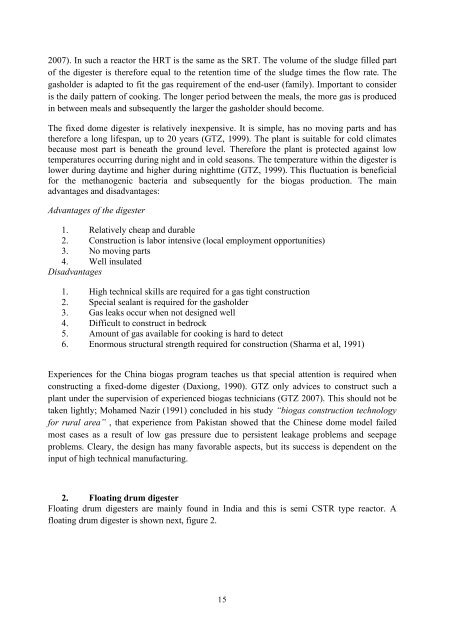Biogas production in climates with long cold winters - SuSanA
Biogas production in climates with long cold winters - SuSanA
Biogas production in climates with long cold winters - SuSanA
Create successful ePaper yourself
Turn your PDF publications into a flip-book with our unique Google optimized e-Paper software.
2007). In such a reactor the HRT is the same as the SRT. The volume of the sludge filled part<br />
of the digester is therefore equal to the retention time of the sludge times the flow rate. The<br />
gasholder is adapted to fit the gas requirement of the end-user (family). Important to consider<br />
is the daily pattern of cook<strong>in</strong>g. The <strong>long</strong>er period between the meals, the more gas is produced<br />
<strong>in</strong> between meals and subsequently the larger the gasholder should become.<br />
The fixed dome digester is relatively <strong>in</strong>expensive. It is simple, has no mov<strong>in</strong>g parts and has<br />
therefore a <strong>long</strong> lifespan, up to 20 years (GTZ, 1999). The plant is suitable for <strong>cold</strong> <strong>climates</strong><br />
because most part is beneath the ground level. Therefore the plant is protected aga<strong>in</strong>st low<br />
temperatures occurr<strong>in</strong>g dur<strong>in</strong>g night and <strong>in</strong> <strong>cold</strong> seasons. The temperature <strong>with</strong><strong>in</strong> the digester is<br />
lower dur<strong>in</strong>g daytime and higher dur<strong>in</strong>g nighttime (GTZ, 1999). This fluctuation is beneficial<br />
for the methanogenic bacteria and subsequently for the biogas <strong>production</strong>. The ma<strong>in</strong><br />
advantages and disadvantages:<br />
Advantages of the digester<br />
1. Relatively cheap and durable<br />
2. Construction is labor <strong>in</strong>tensive (local employment opportunities)<br />
3. No mov<strong>in</strong>g parts<br />
4. Well <strong>in</strong>sulated<br />
Disadvantages<br />
1. High technical skills are required for a gas tight construction<br />
2. Special sealant is required for the gasholder<br />
3. Gas leaks occur when not designed well<br />
4. Difficult to construct <strong>in</strong> bedrock<br />
5. Amount of gas available for cook<strong>in</strong>g is hard to detect<br />
6. Enormous structural strength required for construction (Sharma et al, 1991)<br />
Experiences for the Ch<strong>in</strong>a biogas program teaches us that special attention is required when<br />
construct<strong>in</strong>g a fixed-dome digester (Daxiong, 1990). GTZ only advices to construct such a<br />
plant under the supervision of experienced biogas technicians (GTZ 2007). This should not be<br />
taken lightly; Mohamed Nazir (1991) concluded <strong>in</strong> his study “biogas construction technology<br />
for rural area” , that experience from Pakistan showed that the Ch<strong>in</strong>ese dome model failed<br />
most cases as a result of low gas pressure due to persistent leakage problems and seepage<br />
problems. Cleary, the design has many favorable aspects, but its success is dependent on the<br />
<strong>in</strong>put of high technical manufactur<strong>in</strong>g.<br />
2. Float<strong>in</strong>g drum digester<br />
Float<strong>in</strong>g drum digesters are ma<strong>in</strong>ly found <strong>in</strong> India and this is semi CSTR type reactor. A<br />
float<strong>in</strong>g drum digester is shown next, figure 2.<br />
15
















